Page 452 of 531
AIR CONDITIONER MAINTENANCE
For best possible performance, your air conditioner
should be checked and serviced by an authorized dealer
at the start of each warm season. This service should
include cleaning of the condenser fins and a system
performance check. Drive belt tension should also be
checked at this time.WARNING!
²Use only refrigerants and compressor lubricants
approved by the manufacturer for your air condi-
tioning system. Some unapproved refrigerants are
flammable and can explode, injuring you. Other
unapproved refrigerants or lubricants can cause
the system to fail, requiring costly repairs. Refer to
Section 3 of the Warranty Information book for
further warranty information.
²The air conditioning system contains refrigerant
under high pressure. To avoid risk of personal
injury or damage to the system, adding refrigerant
or any repair requiring lines to be disconnected
should be done by an experienced repairman.
450 MAINTAINING YOUR VEHICLE
Page 453 of 531
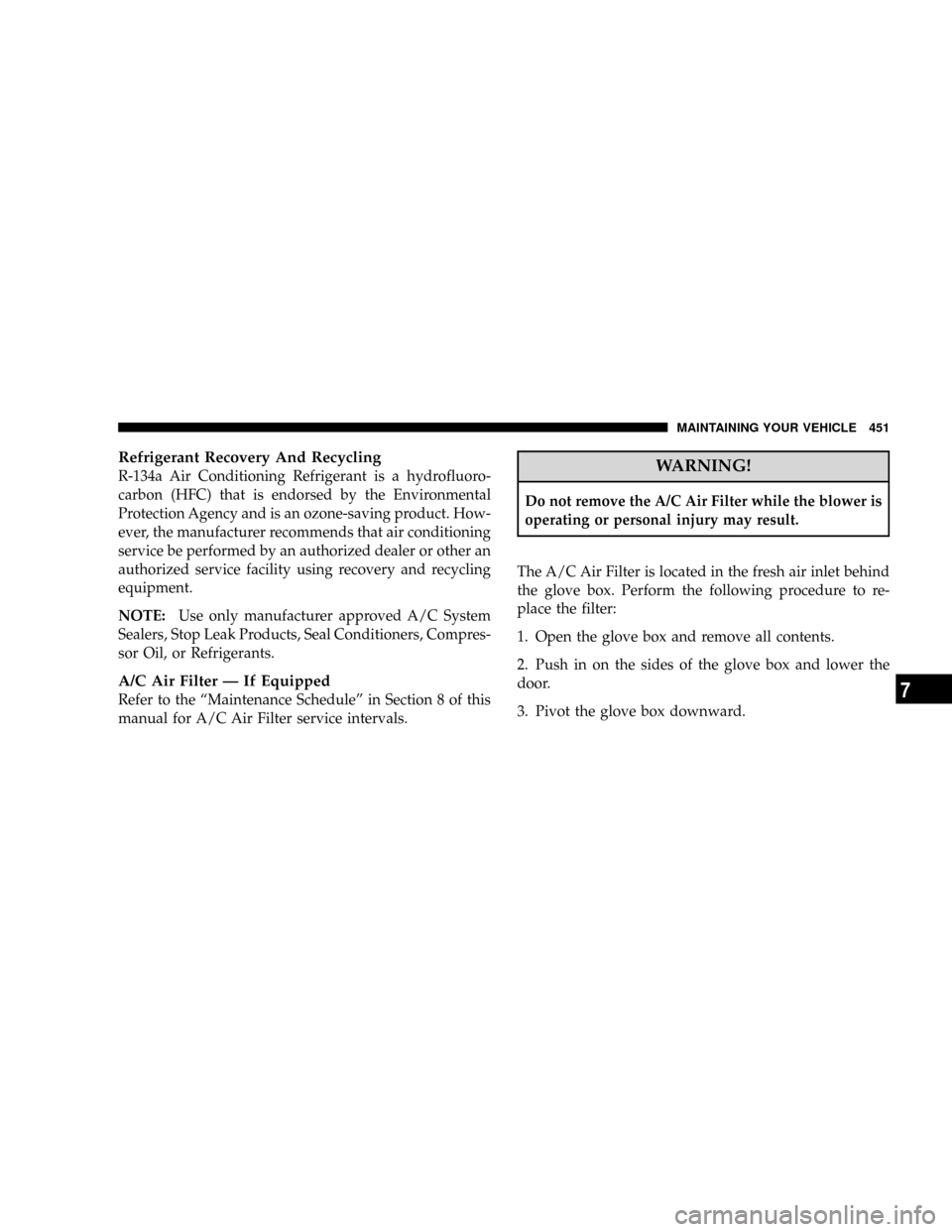
Refrigerant Recovery And Recycling
R-134a Air Conditioning Refrigerant is a hydrofluoro-
carbon (HFC) that is endorsed by the Environmental
Protection Agency and is an ozone-saving product. How-
ever, the manufacturer recommends that air conditioning
service be performed by an authorized dealer or other an
authorized service facility using recovery and recycling
equipment.
NOTE:Use only manufacturer approved A/C System
Sealers, Stop Leak Products, Seal Conditioners, Compres-
sor Oil, or Refrigerants.
A/C Air Filter Ð If Equipped
Refer to the ªMaintenance Scheduleº in Section 8 of this
manual for A/C Air Filter service intervals.
WARNING!
Do not remove the A/C Air Filter while the blower is
operating or personal injury may result.
The A/C Air Filter is located in the fresh air inlet behind
the glove box. Perform the following procedure to re-
place the filter:
1. Open the glove box and remove all contents.
2. Push in on the sides of the glove box and lower the
door.
3. Pivot the glove box downward.
MAINTAINING YOUR VEHICLE 451
7
Page 462 of 531
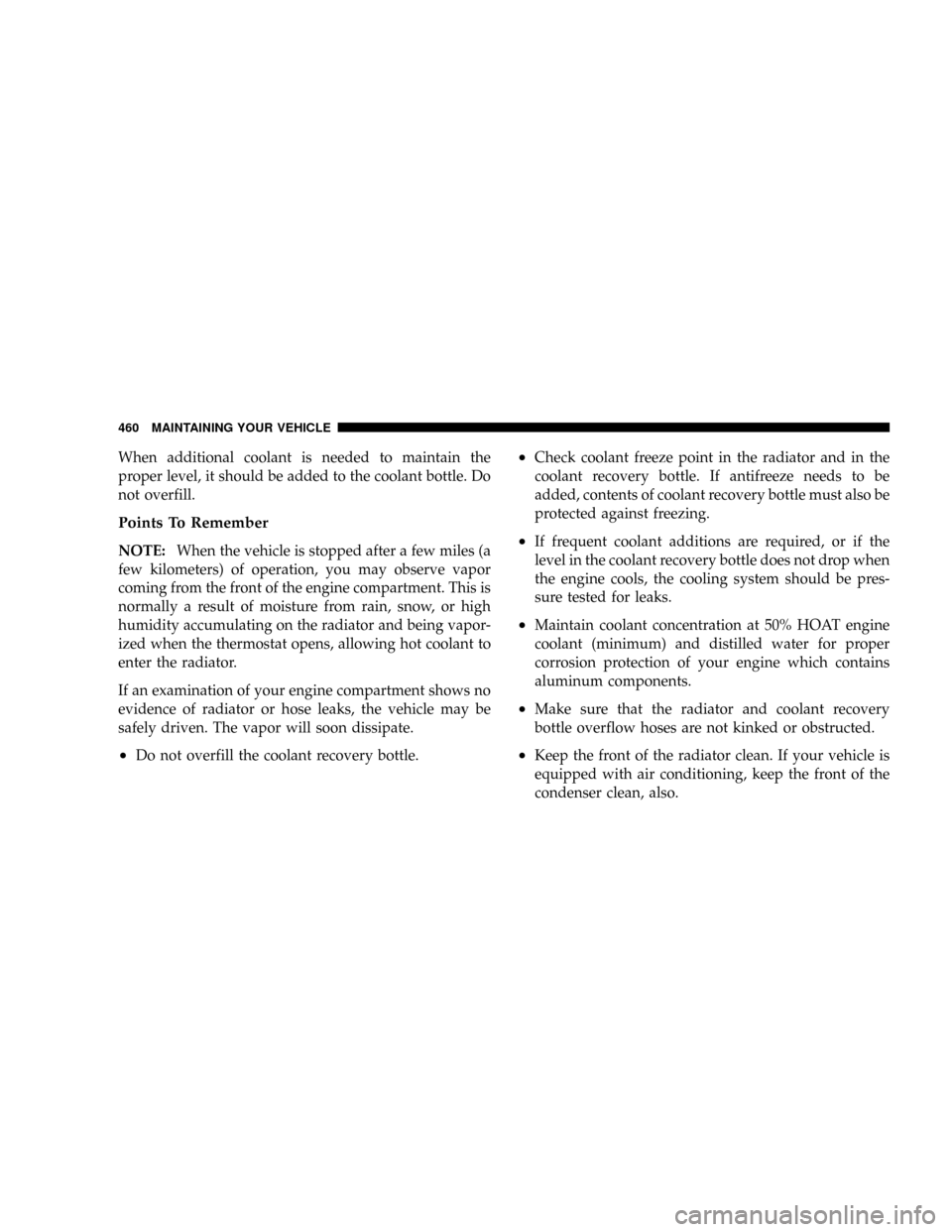
When additional coolant is needed to maintain the
proper level, it should be added to the coolant bottle. Do
not overfill.
Points To Remember
NOTE:When the vehicle is stopped after a few miles (a
few kilometers) of operation, you may observe vapor
coming from the front of the engine compartment. This is
normally a result of moisture from rain, snow, or high
humidity accumulating on the radiator and being vapor-
ized when the thermostat opens, allowing hot coolant to
enter the radiator.
If an examination of your engine compartment shows no
evidence of radiator or hose leaks, the vehicle may be
safely driven. The vapor will soon dissipate.
²Do not overfill the coolant recovery bottle.
²Check coolant freeze point in the radiator and in the
coolant recovery bottle. If antifreeze needs to be
added, contents of coolant recovery bottle must also be
protected against freezing.
²If frequent coolant additions are required, or if the
level in the coolant recovery bottle does not drop when
the engine cools, the cooling system should be pres-
sure tested for leaks.
²Maintain coolant concentration at 50% HOAT engine
coolant (minimum) and distilled water for proper
corrosion protection of your engine which contains
aluminum components.
²Make sure that the radiator and coolant recovery
bottle overflow hoses are not kinked or obstructed.
²Keep the front of the radiator clean. If your vehicle is
equipped with air conditioning, keep the front of the
condenser clean, also.
460 MAINTAINING YOUR VEHICLE
Page 470 of 531
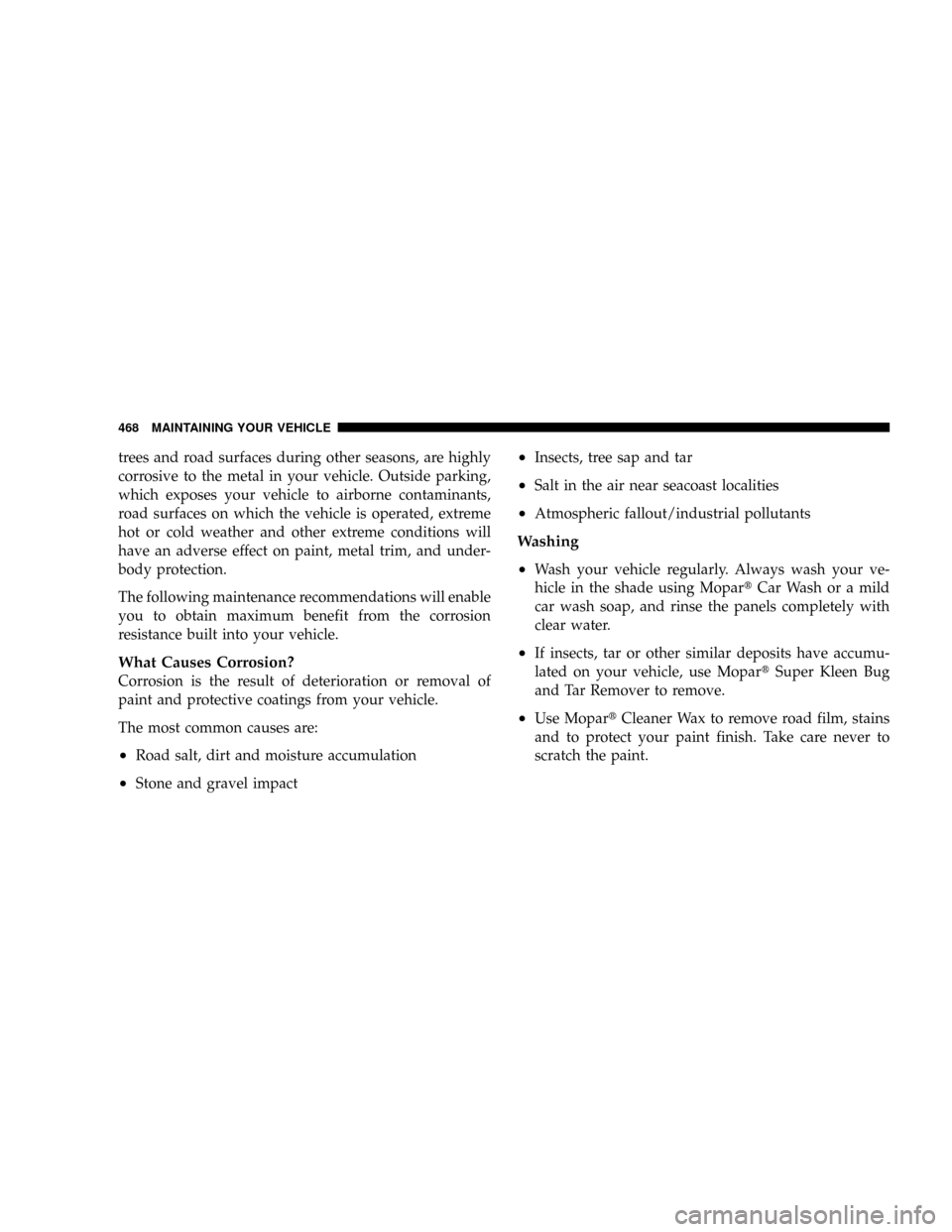
trees and road surfaces during other seasons, are highly
corrosive to the metal in your vehicle. Outside parking,
which exposes your vehicle to airborne contaminants,
road surfaces on which the vehicle is operated, extreme
hot or cold weather and other extreme conditions will
have an adverse effect on paint, metal trim, and under-
body protection.
The following maintenance recommendations will enable
you to obtain maximum benefit from the corrosion
resistance built into your vehicle.
What Causes Corrosion?
Corrosion is the result of deterioration or removal of
paint and protective coatings from your vehicle.
The most common causes are:
²Road salt, dirt and moisture accumulation
²Stone and gravel impact
²Insects, tree sap and tar
²Salt in the air near seacoast localities
²Atmospheric fallout/industrial pollutants
Washing
²
Wash your vehicle regularly. Always wash your ve-
hicle in the shade using MopartCar Wash or a mild
car wash soap, and rinse the panels completely with
clear water.
²If insects, tar or other similar deposits have accumu-
lated on your vehicle, use MopartSuper Kleen Bug
and Tar Remover to remove.
²Use MopartCleaner Wax to remove road film, stains
and to protect your paint finish. Take care never to
scratch the paint.
468 MAINTAINING YOUR VEHICLE
Page 479 of 531
FUSES/TIPM
CavityCartridge
FuseMini
FuseDescription
M12 Ð 30 Amp
GreenAmplifier (AMP)
M13 Ð 20 Amp
YellowIgnition Off DrawÐ
Cabin Compartment
Node (IOD-CCN), Wire-
less Control Module
(WCM), SIREN, Clock
Module (CLK MOD),
Multi-Function Control
Switch (MULTIFCTN
SW)
M14 Ð 20 Amp
YellowTrailer Tow (Export
Only)FUSES/TIPM
CavityCartridge
FuseMini
FuseDescription
M15 Ð 20 Amp
YellowCOL MOD, IR SNS,
Heater Ventilation, Air
Conditioning/Automatic
Temperature Control
(HVAC/ATC), Rear View
Mirror (RR VW MIR),
Cabin Compartment
Node (CCN), Transfer
Case Switch (T-CASE
SW), RUN/ST, Multi-
Function Control Switch
(MULTIFTCN SW), Tire
Pressure Monitor (TPM),
Glow Plug Module
(GLW PLG MOD) Ð Ex-
port Diesel Only
M16 Ð 10 Amp
RedOccupant Restraint
Controller/Occupant
Classification Module
(ORC/OCM)
MAINTAINING YOUR VEHICLE 477
7
Page 481 of 531
FUSES/TIPM
CavityCartridge
FuseMini
FuseDescription
M29 Ð 10 Amp
RedOccupant Classification
Module (OCM)
M30 Ð 15 Amp
BlueRear Wiper Module (RR
WIPER MOD), Power
Folding Mirror (PWR
FOLD MIR)
M31 Ð 20 Amp
YellowBack-Up Lamps (B/U
LAMPS)
M32 Ð 10 Amp
RedOccupant Restraint Con-
troller (ORC), TT EU-
ROPE
M33 Ð 10 Amp
RedNext Generation Control-
ler (NGC), Global Power-
train Engine Controller
(GPEC)FUSES/TIPM
CavityCartridge
FuseMini
FuseDescription
M34 Ð 10 Amp
RedPark Assist (PRK ASST),
Heater Ventilation, Air
Conditioning Module
(HVAC MOD), Head-
lamp Wash (HDLP
WASH), Compass (COM-
PAS)
M35 Ð 10 Amp
RedHeated Mirrors
M36 Ð 20 Amp
YellowPower Outlet #3 (BATT)
M37 Ð 10 Amp
RedAnti-Lock Brake System
(ABS), Electronic Stabil-
ity Program (ESP), Stop
Lamp Switch (STP LP
SW), Fuel Pump Rly Hi
Control
MAINTAINING YOUR VEHICLE 479
7
Page 483 of 531
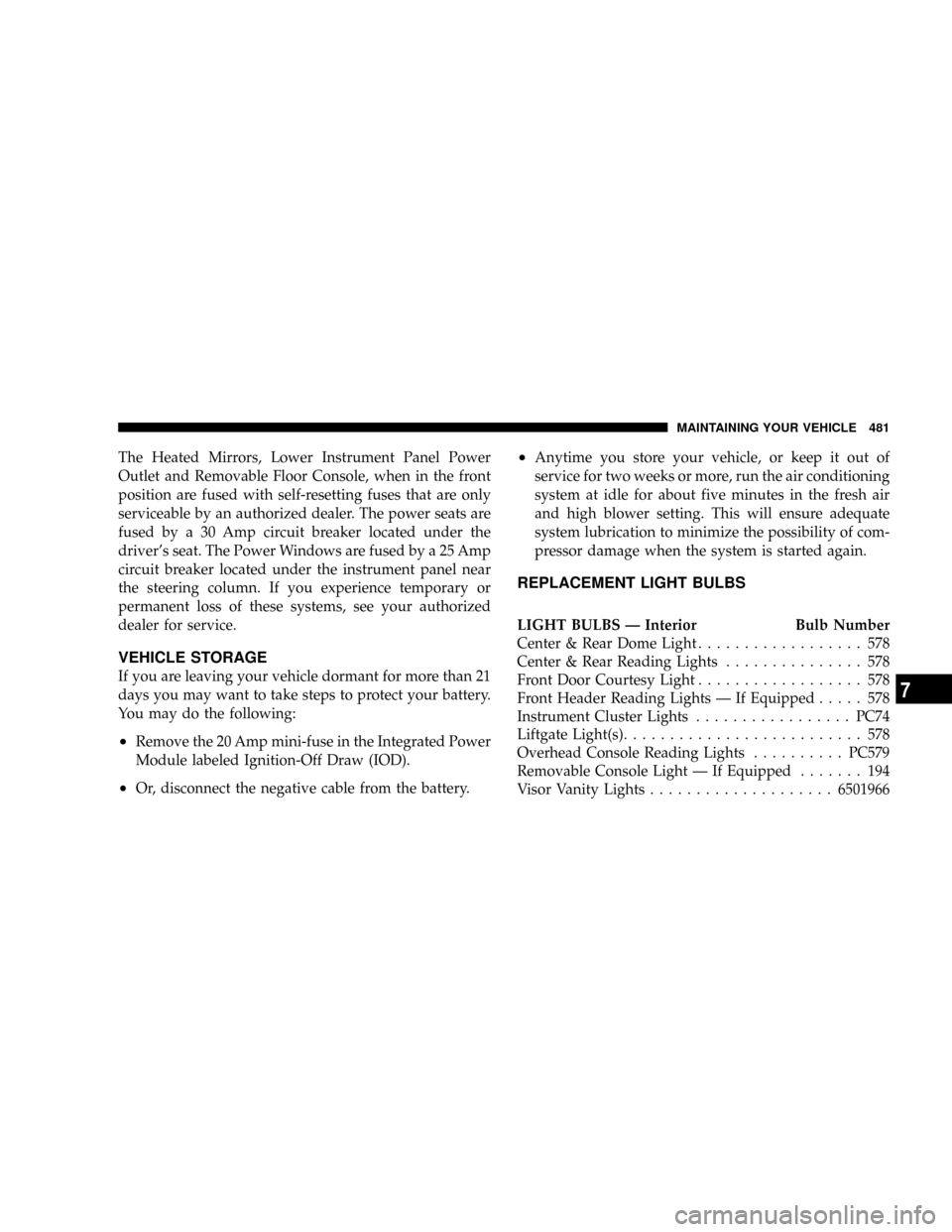
The Heated Mirrors, Lower Instrument Panel Power
Outlet and Removable Floor Console, when in the front
position are fused with self-resetting fuses that are only
serviceable by an authorized dealer. The power seats are
fused by a 30 Amp circuit breaker located under the
driver's seat. The Power Windows are fused by a 25 Amp
circuit breaker located under the instrument panel near
the steering column. If you experience temporary or
permanent loss of these systems, see your authorized
dealer for service.
VEHICLE STORAGE
If you are leaving your vehicle dormant for more than 21
days you may want to take steps to protect your battery.
You may do the following:
²Remove the 20 Amp mini-fuse in the Integrated Power
Module labeled Ignition-Off Draw (IOD).
²Or, disconnect the negative cable from the battery.
²Anytime you store your vehicle, or keep it out of
service for two weeks or more, run the air conditioning
system at idle for about five minutes in the fresh air
and high blower setting. This will ensure adequate
system lubrication to minimize the possibility of com-
pressor damage when the system is started again.
REPLACEMENT LIGHT BULBS
LIGHT BULBS Ð Interior Bulb Number
Center & Rear Dome Light.................. 578
Center & Rear Reading Lights............... 578
Front Door Courtesy Light.................. 578
Front Header Reading Lights Ð If Equipped..... 578
Instrument Cluster Lights.................PC74
Liftgate Light(s).......................... 578
Overhead Console Reading Lights..........PC579
Removable Console Light Ð If Equipped....... 194
Visor Vanity Lights....................6501966
MAINTAINING YOUR VEHICLE 481
7
Page 492 of 531
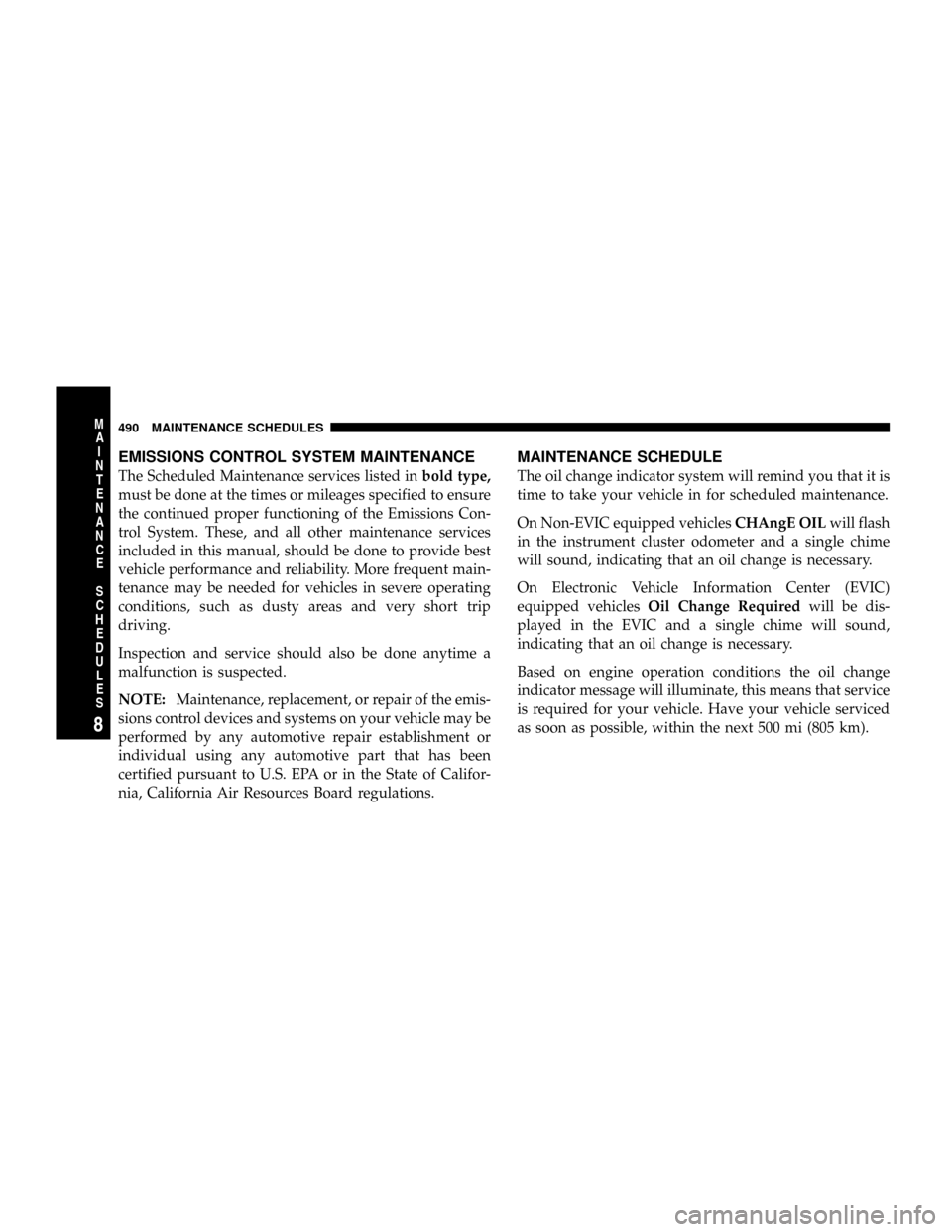
EMISSIONS CONTROL SYSTEM MAINTENANCE
The Scheduled Maintenance services listed inbold type,
must be done at the times or mileages specified to ensure
the continued proper functioning of the Emissions Con-
trol System. These, and all other maintenance services
included in this manual, should be done to provide best
vehicle performance and reliability. More frequent main-
tenance may be needed for vehicles in severe operating
conditions, such as dusty areas and very short trip
driving.
Inspection and service should also be done anytime a
malfunction is suspected.
NOTE:Maintenance, replacement, or repair of the emis-
sions control devices and systems on your vehicle may be
performed by any automotive repair establishment or
individual using any automotive part that has been
certified pursuant to U.S. EPA or in the State of Califor-
nia, California Air Resources Board regulations.
MAINTENANCE SCHEDULE
The oil change indicator system will remind you that it is
time to take your vehicle in for scheduled maintenance.
On Non-EVIC equipped vehiclesCHAngE OILwill flash
in the instrument cluster odometer and a single chime
will sound, indicating that an oil change is necessary.
On Electronic Vehicle Information Center (EVIC)
equipped vehiclesOil Change Requiredwill be dis-
played in the EVIC and a single chime will sound,
indicating that an oil change is necessary.
Based on engine operation conditions the oil change
indicator message will illuminate, this means that service
is required for your vehicle. Have your vehicle serviced
as soon as possible, within the next 500 mi (805 km).
490 MAINTENANCE SCHEDULES
8
M
A
I
N
T
E
N
A
N
C
E
S
C
H
E
D
U
L
E
S